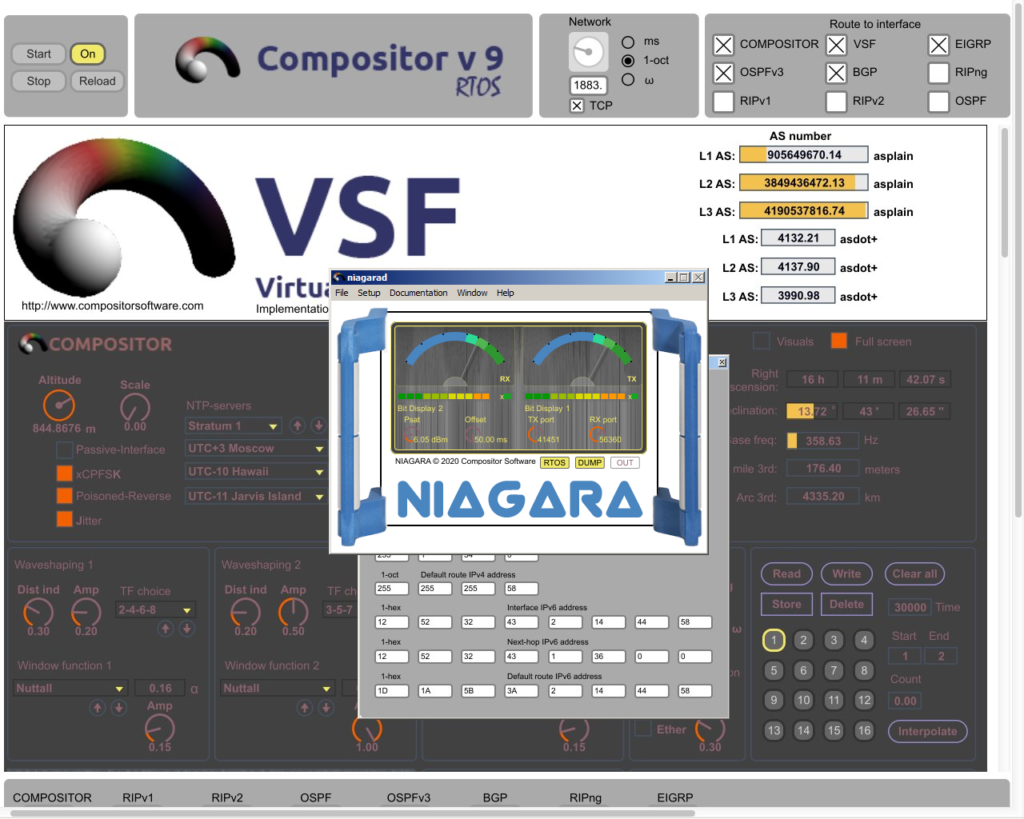Niagara 18 software modem review
All Niagara series products are the software modems, which use middleware and dump, produced in Compositor RTOS 9.0.2. I present to you Niagara 18 software modem, which has an extended documentation (part on Russian, part on English languages). Niagara 18 software modem middleware supports EIGRP, RIPng, BGP4+, OSPFv3 protocols, default route from EIGRP, full work in loopback interface mode, NTP-servers setup via command line interface, connection to VRF objects for work with BGP protocol, an ability to construct VLAN topology and 3D-orientation of virtual optical port (VOP) waveguide.

Niagara 18 software modem, developed by Compositor Software, and modem, developed for Ethernet and Wi-Fi networks, concept is different. For example, Niagara 18 software modem doesn’t require the physical network connection. An abundance of services, which enables the Niagara 18 software modem, compensates the comprehensive demands to virtual communication networks. EIGRP, RIPng and BGP4+ routing protocols allow creating IPsec and GRE tunneling. An ability to use synchro code of different NTP-servers allows rebuilding the home system on a remote destination completely. Using this software modem, you can remotely use OSPFv3 without BGP4+ protocol that was unavailable before, due to physical limitations of Ethernet systems. By entering the remote home system, you can aggregate the shortest path of that area, which you are managing remotely. The route counting performs in real-time that is why you can use IPv4 mask to set IPv6 addresses of remote area devices. You can also multiplex areas, achieving the route end by supernet aggregation, using VRF objects. Such approach can cause the redistributed overloads without graceful restart (GR), because Ethernet-interface uses only phase-locked loop.
VSF platform supports up to 960 simultaneous communication channels and can be reached via Niagara 18 software modem middleware. This number of channels was aggregated on CP-6137-960FX server VSF platform, which produced this middleware. This way, you inherit the number of channels from the server version, but they can’t be used all simultaneously. At the present moment, Niagara 18 software modem middleware supports up to 96 communication channels of L1, L2, L3 layers (OSI model). Niagara 18 software modem gives access to virtual optical network (VON), which consists of 2213 EB of information on the 6, November 2018. At the present day, this index is twice more. Information of VON is stored on servers in Spain, USA, Germany, Sweden and other countries of the world. Trunks of virtual optical communication connect the autonomous systems (AS). Most of the AS’s of VON can interconnect by BGP protocol. To form its own autonomous system Compositor Software uses Niagara 18 software modem with a set of 7539 VRF objects. The routing inside an area performed by OSPFv3 protocol to discover the routes by link state and by RIPng protocol for distance-vector discovery in IPv6 protocol. This way, Niagara 18 software modem is a complete IPv6 software modem back compatible with IPv4 protocol.
Niagara 18 software modem has middleware recorded without intermediate frequency in 150-350 GHz range (EHF) and works in that frequency range. To the day, this frequency range is not supported by any standards, such as 5G and forthcoming 6G networks. This frequency range supported only by satellite communication systems, such as radio telescopes. Niagara 18 software modem is accompanied by a set of 7539 satellite signals in PCM format, which gives access to autonomous systems. That is why you can rank Niagara 18 software modem as the satellite software modem. The connection to the Niagara 18 software modem network is performed in several dump submissions from 10 to 30 seconds. Niagara 18 software modem ether allows GR, which performed every minute to reveal active devices in remote AS. You can select such devices in a moment, when GR is performed as GR helpers. Each GR helper device subscribed on Niagara 18 software modem routing table updates. Niagara 18 software modem performs GR each minute to work under OVERLOAD conditions, which is set by default to test the saturation power of VOP.
The maximum transmission speed of Niagara 18 software modem is 24 * 350000000000 = 8400000000000 bit/s or 8.4 Tbit/s. Middleware and dump recorded at 192000 Hz 24-bit. Flow was recorded from 150-350 GHz frequency range and that is why I take the highest frequency in a moment of flow fixation and multiply it on the bit depth of flow export recording. This way, the moment of time exists for middleware, when this flow was in ether. Moment of time depends on the quantity of scanned autonomous systems. In hyperconverged networks, there is a trend to big trunks between AS areas, which span on many kilometers. That is why data flow in this AS can pass around for the time from 50 to 3000 ms, which is the boundary limits of Niagara 18 software modem. GRE tunneling is used for star topology AS’s and IPsec is used for point-to-point topologies. That is why, GRE performs its pass through the five boundary points of the route and IPsec connects only to the Area Boundary Router (ABR) of OSPF area. That is why, when you use GRE tunneling, feedback loops emerge, if your loopback interface of VOP is set to the same port as the destination port of AS. Such loops can exist for a long time and packets forward between loopback interface and AS loop.
When you use software compensation of feedback loops the decay of data flow carrier signal performed, lowering the ingress que and discarding the packets. Saturation of carrier signals, encased in window function is so high that ingress load redistribution can’t cope with such amount of data flows. In this situation, Niagara 18 software modem performs multicast translation on group of ports. You can reach this by setting AS, which consists of several topological areas, connected by different protocols. This way, ABR’s will perform redistribution of one protocol in another. You can learn information about ingress port of system by changing the egress port, setting eye-mask on 0 (turning RTOS off) and perform GR of all the devices, connected to that port. By making GR of the boundary device and not the Niagara 18 software modem, you can estimate the number of channels, connected to ABR, which in turn can lead to connection with those devices. This way, you perform the redistribution of local que on remote devices.
As mentioned earlier, Niagara 18 software modem makes connection to 7539 AS’s to the day, however the summary aggregation of VON is 3321900 autonomous systems. This way, dump allows connecting not only to those AS’s, which recorded in it, but to discover other AS’s using BGP protocol, which were scanned by VSF platform. The connection to satellite set is performed faster, than in software modem produced in Compositor Hypervisor 9.0.1 a15. It has the connection speed of 24 frames per second, but Niagara 18 software modem has the speed of 34 frames per second. Such speed of deployment allows multiplexing a network much faster, performing supernet summary in 3-6 dump rounds.
Niagara 18 software modem is a sampler technology, that is why it performs the cycle of Compositor RTOS 9.0.2 a11 feedback loop, where a dump is the recording of VSF platform data flows aggregation of that RTOS. Niagara 18 software modem is based on the identity principle and uses PCM recording as a middleware, which doesn’t consume many resources. CP-6137-960FX server consumes up to 35% using 192000 Hz discretization frequency. Which theoretically can allow using it in real-time on the higher discretization frequencies. Niagara 18 software modem consumes little system memory resources and has very fast response to CPU commands speed. It has a little delay time, which allows using it as a hard real-time RTOS.
You can setup monitoring of Niagara 18 software modem via amateur radio software such as TrueTTY and Fldigi. The teletype network flow modified by Niagara 18 software modem includes satellites and servers of Compositor RTOS 9.0.2 a11 management information base. You can composite commands of interface and protocol programming, such as CISCO-like commands. There is a documentation supplied together with Niagara 18 software modem of 2663 pages, with Russian language translated part of more than 1000 pages, spanning over 5 parts with 73 chapters of 131 chapters in total.
There are no obstacles for VON in comparison to traditional radio communication. Radio notation in conventional frequency style is made for notes and reverse compatibility with generic radio protocols. The connection is made via so-called collisions and time-space convolutions, which is a subject of NIM (Nuclear Instrumentation Module) learning curve, to which Niagara 18 software modem relates.
Niagara 18 software modem review:
- Split Horizon support
- 3321900 AS’s in VSF platform
- EHF frequency range (150-300 GHz)
- 8.4 Tbit/s transmission speed
- OVERLOAD work mode
- Poisoned reverse with -rm ability
- 34 fps connection speed
- No delay time
- Management and monitoring via teletype network
